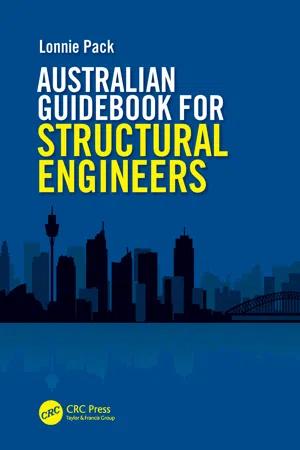
- 490 pages
- English
- ePUB (mobile friendly)
- Available on iOS & Android
Australian Guidebook for Structural Engineers
About This Book
This guidebook is a practical and essential tool providing everything necessary for structural design engineers to create detailed and accurate calculations.
Basic information is provided for steel, concrete and geotechnical design in accordance with Australian and international standards. Detailed design items are also provided, especially relevant to the mining and oil and gas industries. Examples include pipe supports, lifting analysis and dynamic machine foundation design.
Steel theory is presented with information on fabrication, transportation and costing, along with member, connection, and anchor design. Concrete design includes information on construction costs, as well as detailed calculations ranging from a simple beam design to the manual production of circular column interaction diagrams. For geotechnics, simple guidance is given on the manual production and code compliance of calculations for items such as pad footings, piles, retaining walls, and slabs. Each chapter also includes recommended drafting details to aid in the creation of design drawings.
More generally, highly useful aids for design engineers include section calculations and force diagrams. Capacity tables cover real-world items such as various slab thicknesses with a range of reinforcing options, commonly used steel sections, and lifting lug capacities. Calculations are given for wind, seismic, vehicular, piping, and other loads. User guides are included for Space Gass and Strand7, including a non-linear analysis example for lifting lug design. Users are also directed to popular vendor catalogues to acquire commonly used items, such as steel sections, handrails, grating, grouts and lifting devices.
This guidebook supports practicing engineers in the development of detailed designs and refinement of their engineering skill and knowledge.
Frequently asked questions
Information
Document number | Description |
A1-ST-DC-0001_01 | Structural design criteria |
A1-ST-IN-0001_01 | Steel drawing index |
A1-ST-SD-0001_01 | Steel standard notes |
A1-ST-SD-0001_02 | Steel standard drawing 2 – Bolted connections |
A1-ST-SD-0001_03 | Steel standard drawing 3 – Base plates |
A1-S... |
Table of contents
- Cover
- Half-Title
- Title
- Copyright
- SAI GLOBAL
- Contents
- Preface
- Author
- 1 Setting up the project
- 2 Design
- 3 Steel design
- 4 Concrete design
- 5 Geotechnical
- 6 Design items
- 7 Design aids
- 8 Vendor catalogues
- 9 Notations and abbreviations
- References
- Index